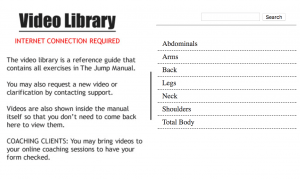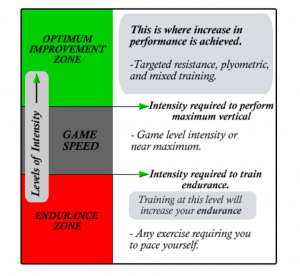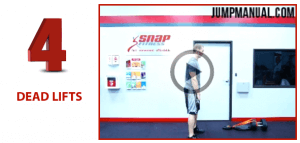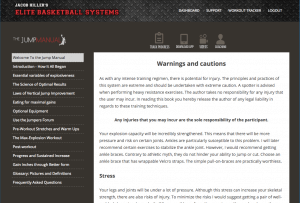Being able to dunk is the ultimate bragging right for every basketball player! It makes you more dangerous at attacking the rim, enables monster blocks, and allows you to get rebounds you should have no business pursuing...
So it's no wonder that there are dozens of vertical jump training programs out there, all promising you incredible increases to your vertical! But do they actually work?
My goal with this blog is to examine every popular vertical jump program to find out if the deliver on their promise and help you to find out which one fits you best. You can find my comparison of the best vertical jump programs here.
Today, we will be looking into one program that has been around for a while and is still very popular - the Jump Manual!
The Beginnings of the Jump Manual
So he began to study the science of athletic performance and started to experiment on his own. And he found a combination of workouts that increased his vertical jump all the way to a 45 inch vertical - the Jump Manual was born!
The program was released in 2008 and since then has helped thousands of athletes to reach their dream of dunking. And even 10 years later, at age 35, Jacob Hiller's vertical is still impressive!
Let's get to know the Jump Manual program:
Presentation
Once you enter the membership section of the Jump Manual you see an overview of all the information included in the program. And that's a lot of information!
The Jump Manual is structured like a book with different chapters explaining warm up routines, proper nutrition and the exercises of the jump training program. If you read through all of it, not only will you understand how the Jump Manual works but also gain a pretty good understanding of the science behind vertical jump training.
Other programs just give you a list of exercises to do, but with the Jump Manual, you gain knowledge that will be helpful even when you are no longer doing the Jump Manual!
Some impressions from the Jump Manual website:
The Jump Manual was created in 2008 and, unfortunately, the website really shows age. The navigation can be frustrating at times and the website is not very well optimized for mobile phones. The old age of the program shows most in the quality of the videos. The picture quality and resolution just aren't up to modern standards any more.
Jump Manual Workouts
In the membership section of the Jump Manual, you will find a workout chart that consists of 14 days (afterward you start over from the beginning) that tells you exactly what to do during each day. During these 14 days you are going to do:
Plyometric Jump Training (2 times):
Exercises like depth jumps or medicine ball throws work on your explosiveness and teach your body how to quickly mobilize a lot of muscle fibers for a quicker and more powerful vertical jump. These exercises increase your vertical by teaching your central nervous system how to work more efficiently and effectively. Expect the plyometric workouts to last around 90 minutes including warm up and cool down.
Lower Body Strength Training (2 times):
The lower body workouts combine heavy weightlifting exercises like deadlifts and squats with more explosive movements like hang cleans. During these workouts, you not only strengthen the muscles that you need during a vertical jump, but you also teach them to use their strength in a quick and powerful fashion. To perform this workout you will need access to a gym with squat racks and heavy barbells. If you don't have a gym membership then there are bodyweight alternatives, but of course these exercises will limit the effect of the workout quite a bit.
Overall this workout consists of seven different exercises of which you will be doing four sets. Combined with warm up, cool down and getting to the gym this workout takes 2 hours pretty easily.
Core Body workouts (4 times):
The core series is a rather short workout that you can do at home. Planks and other exercises intend to stabilize your core and improve the transfer of energy during the vertical jump. This workout is rather quick and will probably take you less than 30 minutes.
Stretch and Recover (all off-days):
Yep, you read that right! Even on off-days, you don't really get off. Jacob Hiller provides you with a stretch & recovery routine that will help to improve your flexibility and improve muscular regeneration so that you will be back at 100% for the next workout.
Ease of Use
Difficulty of the exercises:
A lot of the exercises of the Jump Manual are really challenging and rely on correct technique to be executed safely. If you have never done heavy squats or deadlifts you should find a trainer who will teach you proper technique, otherwise, you can easily hurt your knees or screw up your back. This makes the Jump Manual less beginner friendly like the #1 competitor Vert Shock that relies 100% on bodyweight exercises. However, if you are an experienced weightlifter, then the Jump Manual will take advantage of this skill and produce significant (jump-specific!) increases of strength in a short time!
Difficulty of the workout schedule:
Everybody is motivated during the first weeks of a new training program, the hard part is to stick with it until the end. It definitely takes a lot of discipline to make it through 3 months of the Jump Manual as you are doing some kind of workout every day. No Pain, no gain - if you really want to dunk it will take some hard work!
Results of the Jump Manual
Jacob Hiller guarantees an improvement of at least 10 inches to your vertical leap in just 12 weeks. Of course, if you are already jumping 45 inches, your improvements might not be as extreme. But the Jump Manual has been on the market for almost 10 years, sold over 100.000 copies and it is still very popular. This just shows you that the program works!
You can find a lot of great success stories online, check out some of the most incredible ones here.
Is it for you?
Not every program works equally well for everybody. There are different types of athletes who need different types of training to maximize their potential for jumping high.
When it comes to the vertical jump we can divide athletes into two groups:
Single Leg jumpers:
These athletes are usually thin and lanky. They jump higher off of one foot and have very quick and "bouncy" takeoffs. A great example of a one-foot jumper is Zach LaVine.
Two-Foot jumpers:
These jumpers are often very strong and powerful and they do exceptionally well at squatting and deadlifting. Their vertical jump is a lot slower compared to single-leg jumpers, but they compensate this lack of quickness by bending deeper and using their strength to their full advantage. A great example of a player that fits this description is Aaron Gordon.
If you want to see how these two styles of jumping compare, check out the epic 2016 dunk contest. Especially concentrate on the different athletic builds of LaVine (thin and lanky) to Aaron Gordon (muscular) and how ZachLavine uses much more speed and a very short ground contact compared to the slower more forceful Aaron Gordon.
All right, so is the Jump manual a good fit for you?
The Jump Manual relies a lot on heavy weightlifting and is therefore a better fit for two-foot jumpers who might not be as quick but have legs that can produce a lot of power during the takeoff.
Single leg jumpers will still benefit from the improved strength, but a workout that focuses more on advanced plyometrics and quickness like Vert Shock might be a better choice. You can learn more about my own experience during 8 weeks of Vert Shock and how I finally learned to dunk here.
Jump Manual Review Results:
What I liked:
What I didn't like:
A lot of success stories prove that the Jump Manual works and can increase your vertical by up to 10" to 15".
You can get the program for $97 here. Not cheap, but totally worth it if you can learn to dunk!
The web page is a bit outdated and the video quality of the videos is quite poor. However, the program is packed with valuable information.
The Jump Manual includes difficult weightlifting exercises which are not meant for beginners. Prior experience or a good coach required.
Overall Rating: starstarstarstarstar_border(4 / 5 stars)
Jump Manual was developed in 2008 and it shows. It is no longer cutting edge, but it still works!
If you want a program that focuses on strength then this is the perfect program for you!
Alternative: Vert Shock
Vert Shock is an intense 8-week workout that focuses on explosive plyometric exercises and bodyweight strength training. The workouts are presented in short, high-quality videos accompanied by worksheets that tell you exactly what to do.
Check out this blog post to read how it helped me to become a consistent dunker for the first time in my life!

Founder of thehoopsgeek.com. A passionate basketball enthusiast and coding geek, Andy combines a love for sports with technology.












